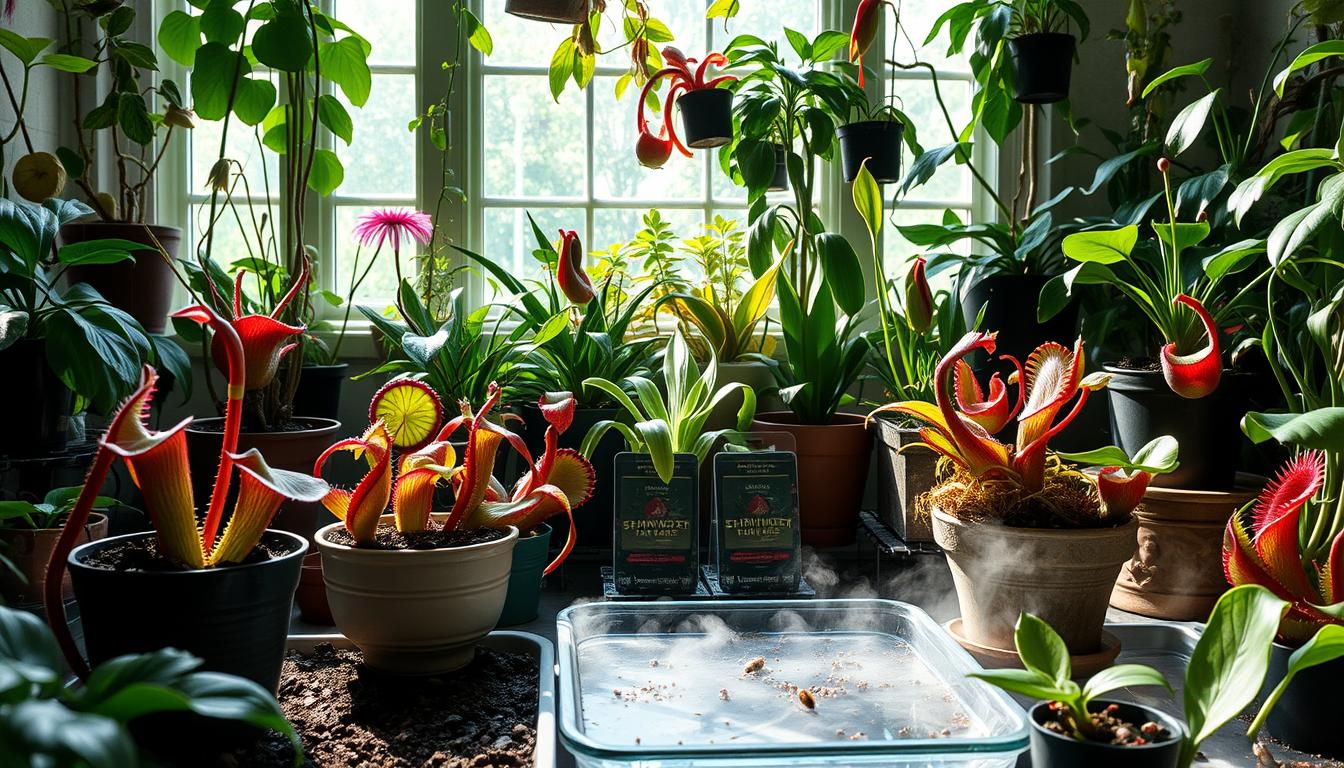Welcome to my carnivorous plant care guide! I’m excited to share my love for these plants with you. As someone who’s grown them for a long time, I’ve learned a lot. In this guide, I’ll cover everything you need to know about taking care of them.
I’ll share my personal experiences and expert tips. This guide is for both beginners and enthusiasts. It will help you grow these amazing plants successfully. Let’s explore the world of carnivorous plants together and learn how to care for them!
Introduction to Carnivorous Plants
Welcome to the fascinating world of carnivorous plants! These plants have evolved to catch and eat insects and small animals. Let’s explore what makes them special and how they thrive in poor soil.
What Are Carnivorous Plants?
Carnivorous plants can trap and digest prey. This helps them survive in places where soil lacks nutrients. They have developed unique ways to catch prey, like sticky leaves or snap traps.
The Fascinating World of Their Diet
The diet of carnivorous plants is amazing. They mostly eat insects, but some can catch small frogs or rodents. Their methods vary:
- Venus flytraps use rapid-closing traps
- Pitcher plants lure prey into slippery, liquid-filled chambers
- Sundews have sticky tentacles that wrap around insects
These different strategies show the incredible ways carnivorous plants adapt to feed.
Common Types of Carnivorous Plants
There are over 750 species of carnivorous plants worldwide. Here are some popular ones you might see:
| Plant Type | Feeding Mechanism | Native Habitat |
|---|---|---|
| Venus Flytrap | Snap Trap | Southeastern United States |
| Pitcher Plant | Pitfall Trap | Various regions worldwide |
| Sundew | Sticky Trap | Every continent except Antarctica |
| Bladderwort | Suction Trap | Freshwater and terrestrial habitats globally |
Each plant offers a unique look into carnivorous plant feeding. As we learn more about their care, you’ll see how to grow these amazing plants at home.
Choosing the Right Carnivorous Plant for You
Finding the perfect carnivorous plant is crucial for a successful plant care journey. I’ve been growing these plants for years and can help you choose. Let’s look at some great options for beginners and enthusiasts.
Beginner-Friendly Species
For beginners, start with these easy-to-grow plants:
- Venus Flytraps: These iconic plants are easy to grow and fun to watch.
- Pitcher Plants: Nepenthes varieties are low-maintenance and visually striking.
- Sundews: Drosera species are small, adaptable, and captivating.
Unique Species for Enthusiasts
For a challenge, try these rare and unique plants:
- Cobra Lilies: Darlingtonia californica offers a rewarding growing experience.
- Butterworts: Pinguicula species have beautiful flowers and sticky leaves.
- Bladderworts: Utricularia are fascinating aquatic or terrestrial plants.
Factors to Consider Before Selecting
Before picking your plant, think about these key factors:
| Factor | Consideration |
|---|---|
| Climate | Match plant needs to your local conditions |
| Space | Ensure you have room for growth and care |
| Time | Consider your availability for plant maintenance |
| Experience | Choose plants that match your skill level |
Choosing the right plant is the first step to a successful carnivorous plant care guide. Take your time, do your research, and enjoy the journey of growing these incredible plants.
Understanding the Natural Habitat
To care for carnivorous plants well, we must mimic their natural habitats. These plants have evolved to live in specific conditions. We need to recreate these conditions at home.
Climate Requirements
Carnivorous plants thrive in different climates. Tropical pitcher plants need warm, humid air. Temperate sundews prefer cooler temperatures.
I research each plant to ensure the right climate. This helps them grow well.
Soil Composition Preferences
The soil mix is crucial for carnivorous plants. They prefer poor, acidic soil. I mix sphagnum moss and perlite for my plants.
This mix helps with drainage and keeps moisture in. It’s perfect for their needs.
Light Conditions for Optimal Growth
Lighting is key for carnivorous plants. Most need bright, indirect sunlight. I place indoor plants near south-facing windows.
For outdoor plants, I choose spots with partial shade. This protects them from strong afternoon sun.
By creating the right habitat, my plants thrive. It’s a bit of work, but it’s rewarding. These plants show off their unique features and colors when cared for properly.
Setting Up the Perfect Environment
Creating the ideal home for your carnivorous plants is crucial for their well-being. I’ve spent years perfecting my setup, and I’m excited to share my insights with you.
Ideal Potting Solutions
Choosing the right container is key for carnivorous plant repotting. I prefer plastic or glazed ceramic pots with drainage holes. These materials help retain moisture without waterlogging the roots.
For soil, I use a mix of sphagnum moss and perlite. This mix mimics their natural habitat.
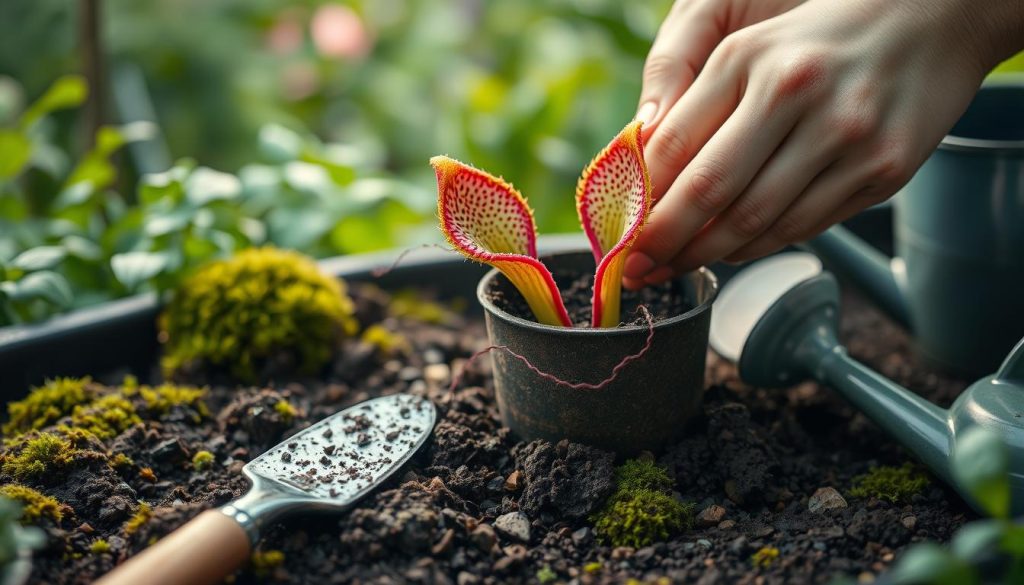
Creating Humidity for Your Plants
Most carnivorous plants thrive in high humidity. I place my pots on trays filled with pebbles and water. As the water evaporates, it creates a humid microclimate.
For extra moisture, I mist my plants daily using distilled water.
Temperature Control Tips
Maintaining the right temperature is vital. I keep my carnivorous plants in a spot where daytime temperatures range from 70-80°F (21-27°C). At night, I let it drop slightly to 60-70°F (15-21°C).
During winter, I move them to a cooler area. This mimics their natural dormancy period.
By following these guidelines, you’ll create a thriving environment for your carnivorous plants. Remember, patience and observation are key as you fine-tune your setup.
Watering Guidelines for Carnivorous Plants
Proper watering is crucial for any carnivorous plant care guide. I’ve found that using the right water and a good schedule keeps them thriving. Let’s explore the best ways to keep your carnivorous plants hydrated and healthy.
Best Practices for Water Quality
I always use rainwater or distilled water for my carnivorous plants. Tap water can harm them with its minerals. I collect rainwater or buy distilled water to ensure they get pure water.
Frequency of Watering
Watering frequency depends on the plant type and season. I keep Venus flytraps and pitcher plants moist. In growing seasons, I water them every 2-3 days. In winter, it’s once a week. Sundews need daily watering.
Signs of Overwatering or Underwatering
Watch for signs of water stress in your plants. Yellow leaves mean too much water, while brown, crispy leaves mean too little. I check soil moisture with my finger. If it’s dry an inch down, it’s time to water. It’s safer to slightly underwater than overwater these plants.
Fertilizing Your Carnivorous Plants
Carnivorous plants need care when it comes to feeding. They can benefit from fertilization, even though many think they don’t need it. Let’s dive into how to feed your carnivorous friends right.
When and How to Fertilize
I fertilize my carnivorous plants in spring and summer. This is when they grow the most. I use a weak, nutrient-rich solution every 2-4 weeks. Foliar sprays are great for most plants, as they mimic their natural diet.
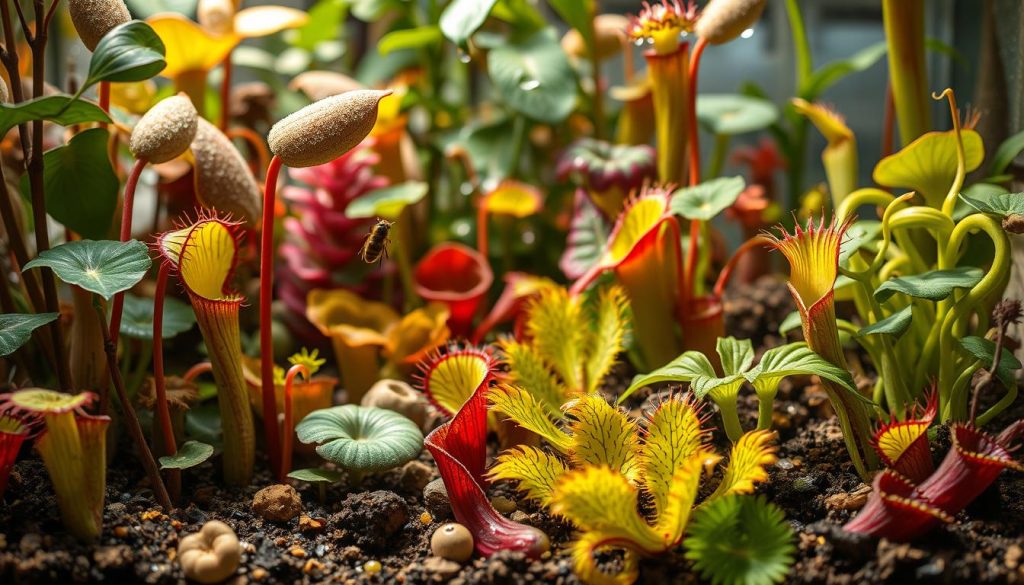
Choosing the Right Fertilizer
For feeding carnivorous plants, I choose fertilizers low in minerals. Orchid fertilizers or those made for carnivorous plants are best. I stay away from regular plant foods, as they can be harmful.
| Fertilizer Type | Pros | Cons |
|---|---|---|
| Orchid Fertilizer | Low in minerals, readily available | May need dilution |
| Carnivorous Plant Fertilizer | Specifically formulated, safe | Can be more expensive |
| Insect-based Nutrients | Natural, mimics wild diet | Preparation can be time-consuming |
Recognizing Fertilizer Burn
Too much fertilizer can harm your plants. Look for signs like brown leaf tips or discoloration. If you see these, flush the soil with distilled water and stop feeding until the plant gets better.
Pest Management Strategies
Carnivorous plants can get pests too. It’s important to control pests to keep them healthy. Let’s look at ways to keep your plants pest-free.
Common Pests and Their Impact
Aphids, mealybugs, and spider mites are common pests. They harm plants by sucking out their fluids. This can stunt growth or even kill the plant if not treated.
Natural Pest Control Methods
Natural methods are best for carnivorous plants. Here are some effective ways to control pests:
- Gently rinse plants with clean water to dislodge pests
- Use a soft brush to remove stubborn insects
- Introduce beneficial predators like ladybugs
- Apply neem oil as a natural pesticide
Chemical Options: What to Avoid
Chemical pesticides can harm your plants. I avoid harsh chemicals. If you must use a chemical, choose one made for carnivorous plants and follow the instructions carefully.
| Pest Control Method | Effectiveness | Safety for Plants |
|---|---|---|
| Water rinse | Moderate | Very safe |
| Neem oil | High | Safe when used correctly |
| Beneficial insects | High | Very safe |
| Chemical pesticides | Very high | Potentially harmful |
Pruning and Maintenance
Keeping your carnivorous plants in top shape is crucial. Regular pruning and maintenance greatly improve their health and look. I’ve learned this from experience.
When to Prune Your Plants
I prune my carnivorous plants when I see dead or dying parts. For Venus flytraps, I remove old traps in spring. Pitcher plants get their old pitchers trimmed in late winter.
Sundews usually need less pruning. But, I remove any brown or mushy leaves as I find them.
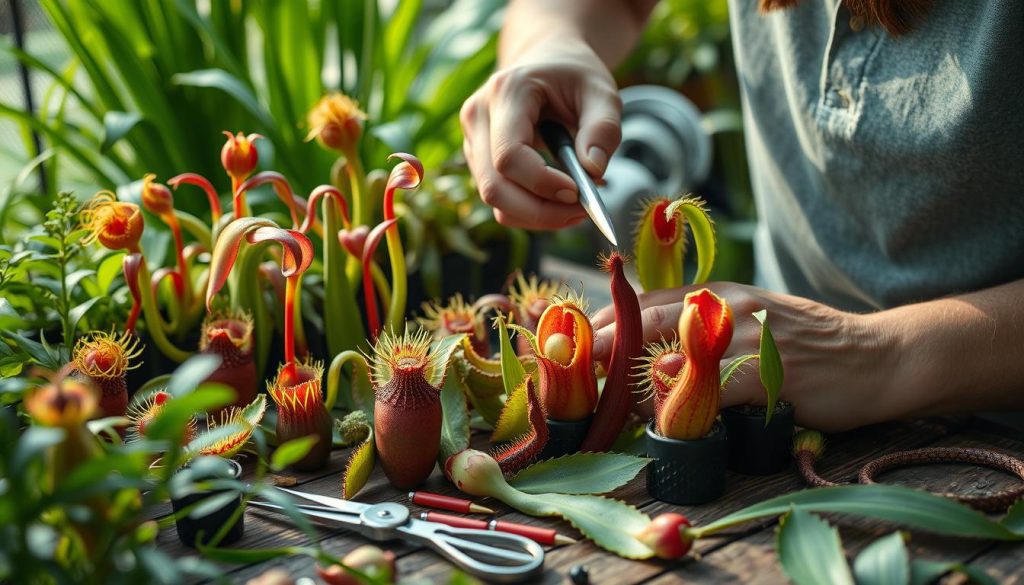
Tools Needed for Successful Pruning
Clean, sharp tools are key for pruning carnivorous plants. I use:
- Small, sharp scissors for precise cuts
- Tweezers for removing tiny dead leaves
- Rubbing alcohol to sterilize tools between plants
These tools help me make clean cuts without harming the plant.
Tips for Keeping Plants Healthy
Beyond pruning, I follow these tips to keep my carnivorous plants thriving:
- Remove any non-carnivorous plants from pots
- Clean traps gently with distilled water if needed
- Check regularly for pests or signs of disease
- Rotate plants for even light exposure
By sticking to these practices, my carnivorous plants have thrived for years.
Propagating Carnivorous Plants
Growing your carnivorous plant collection is an exciting journey. Propagation is a rewarding way to expand your green family. Let’s dive into the methods, timing, and tips to help you succeed.
Methods of Propagation
There are several ways to propagate carnivorous plants. Leaf cuttings, division, and seed sowing have worked well for me. For Venus flytraps, I gently pull a leaf and place it in moist soil.
Pitcher plants often respond well to division, splitting the plant at the roots. Sundews are easy to grow from seeds, which I sprinkle on damp sphagnum moss.
Timing for Best Results
Timing is crucial in carnivorous plant propagation. Spring and early summer are ideal for most methods. This gives new plants plenty of time to establish before winter.
For seeds, I start them indoors in late winter. This allows them to grow strong before moving outside.
Common Mistakes to Avoid
In my propagation journey, I’ve made some mistakes. Overwatering cuttings can lead to rot, so I now use a well-draining mix. Rushing the process is another pitfall. Patience is key – some plants take weeks to show roots.
Lastly, using tap water can harm these sensitive plants. I always use distilled or rainwater for the best results.
| Propagation Method | Best Time | Success Rate |
|---|---|---|
| Leaf Cuttings | Spring | 70% |
| Division | Early Summer | 90% |
| Seed Sowing | Late Winter | 60% |
Seasonal Care Tips
Caring for carnivorous plants means adjusting to their needs all year. These plants do best when we follow their natural cycles. Let’s see how to change our care as the seasons shift.
Adjusting Care for Different Seasons
In spring and summer, I water more and give them bright, indirect light. As fall comes, I water and feed less. In winter, most carnivorous plants need a break, a time called dormancy, to stay healthy.
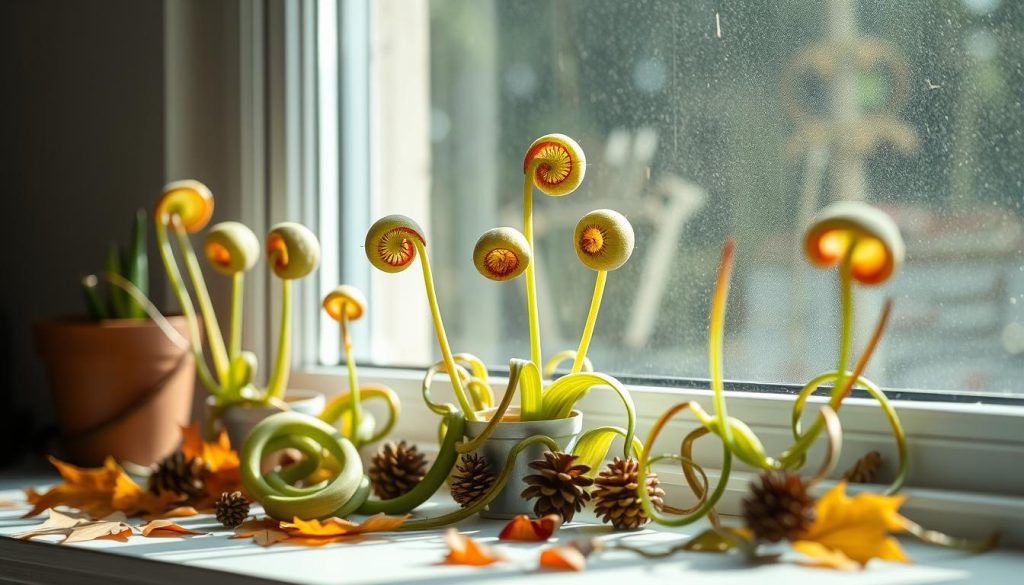
Preparing for Winter Dormancy
To get ready for dormancy, I stop feeding and water less. For plants like Venus flytraps and Sarracenia, I put them in a cool place. Temperate species need cooler temperatures, between 35-50°F. Tropical plants like Nepenthes also need less care in winter.
Spring Awakening Practices
When spring is near, I wake my plants up from dormancy. I start with more light and regular watering. It’s thrilling to see them grow again! I begin feeding once they’re actively growing. Always check what your plant needs, as each is different.
Troubleshooting Common Issues
Growing carnivorous plants can be tricky. In my carnivorous plant care guide, I’ve faced many challenges. Let’s look at how to spot and fix problems.
Identifying Signs of Stress
Carnivorous plants show stress in unique ways. Look for discolored leaves, slow growth, or misshapen traps. These signs often point to specific issues.
Solutions for Common Problems
I’ve found solutions to many carnivorous plant problems. Here’s a quick guide:
| Problem | Solution |
|---|---|
| Yellow leaves | Adjust light exposure |
| Wilting | Check water quality and quantity |
| Trap death | Ensure proper humidity |
| Slow growth | Review soil nutrients |
When to Seek Professional Help
Sometimes, plant issues go beyond basic care. If you see persistent fungal growth, severe discoloration, or rapid decline, it’s time to consult an expert. Local botanical gardens or carnivorous plant societies can offer specialized advice.
Remember, patience is key in carnivorous plant care. With careful observation and timely action, you can overcome most challenges and enjoy healthy, thriving plants.
Conclusion and Additional Resources
As we finish this guide on carnivorous plant care, I’m thrilled to share some great resources. These will help you explore this interesting world, whether you’re new or have experience. They’ll boost your knowledge and skills.
Recommended Books and Websites
“The Savage Garden” by Peter D’Amato is a must-read for deep insights. It covers many carnivorous plants. The International Carnivorous Plant Society’s website (www.carnivorousplants.org) is also a treasure trove. It has lots of care tips and info on different species.
Joining Carnivorous Plant Communities
Connecting with others who love carnivorous plants is very helpful. I recommend joining forums like FlytrapCare.com or local botanical gardens with these plants. These groups are great for sharing stories and getting tips from experts.
My Personal Tips for Success
Patience is crucial when growing carnivorous plants. Start with easy ones like Venus flytraps or pitcher plants. Always use distilled water and don’t overfeed. These plants do best when you don’t fuss over them too much. With these tips and resources, you’re ready to start your carnivorous plant journey!

